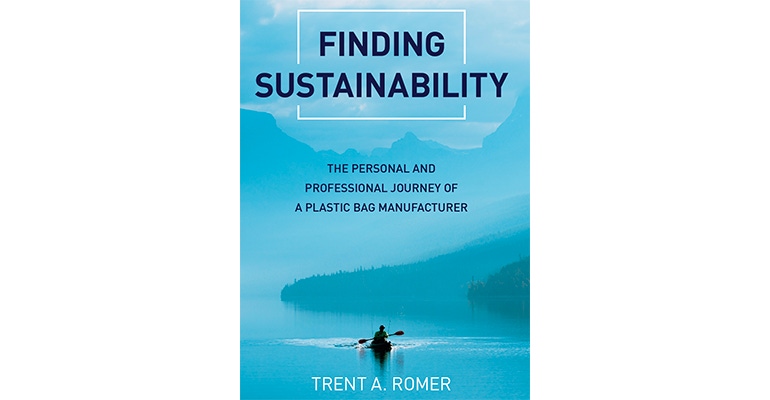Plastic Bag Manufacturer Chronicles His Journey to Sustainability
A third-generation co-owner of the family plastic bag business, Trent Romer explains in his book how sustainability became a guiding principle in his professional and personal life.
July 20, 2021

There aren’t many books written by plastics industry professionals that don’t involve chemistry, and even fewer that moonlight as a travelogue. But Trent A. Romer’s book, Finding Sustainability: The Personal and Professional Journey of a Plastic Bag Manufacturer (Business Books, June 2021), melds his love for the great outdoors with his devotion to the family plastic bag manufacturing business in Albany, NY.
The Clear View Bag Co. began life in 1961 as The Box and Bow. It was started by Romer’s grandparents, Donald and Fulvia Strevell, who sold decorative packaging out of the barn behind their house. That business grew into custom manufacturing of cellophane and polyethylene products.
Like most family businesses, the family was the primary source of labor for the company, and in 2007, Trent’s father sold the company to his two sons. Today, the company makes primarily custom plastic packaging and employs approximately 70 people. Trent Romer has a college degree, including an MS in education and an MBA. Those degrees, along with his life-long experience working in the family business, mean that the third generation has been quite successful.
The manufacturer's duty to the environment.
The cover of the June 2018 issue of National Geographic captured Romer’s attention and got him to thinking about a plastic bag manufacturer’s duty to the environment. The cover depicts the ocean with what appears to be the tip of an iceberg, but below the surface you see that it is a single-use plastic bag. It gave Romer pause, who said that the problem “seemed too large to ignore.”
Those of us who’ve made our careers in the plastics industry cringe when we see plastic in the environment. Earlier today, I looked out my office window and saw a plastic bag blowing across my front yard. A cactus snagged it, holding it firm until I could run out and grab it and take it to my recycling bin before anyone could see it and blame the plastics industry.
Romer adopted a “no waste” mindset, which he embraced “wholeheartedly.” He took three courses in an online platform founded by Harvard and MIT, including The Circular Economy and Sustainable Packaging in a Circular Economy. He learned that “there is no waste in a circular system. Reuse, recycle and compost are the three main paths,” in sustainability.
There isn’t much in Romer’s book I disagree with, but he did mention that some recovered material “turns into lower-quality or lower-functionality products, such as high-quality plastic packaging downcycled into hard plastic fencing.” I’d hardly call Trex or Azek products “downcycling.” If you’ve ever seen these amazing decking and fencing products that last for decades and require very little maintenance, you’d have to agree that these high-quality products made from plastic waste are a perfect solution.
Romer continued his learning journey by attending Ekoplaza in Amsterdam, where he visited a “plastic-free” supermarket, and he attended the EuPC Plastics Strategy Conference in Brussels. He exhibited at Pack Expo, where he began seeking “feedback from the marketplace.” Romer was always on the lookout for ways to learn from others so that he could improve his own efforts toward sustainability, and “navigate the new challenges that threaten” his existence.
Key properties of sustainable alternatives.
In the process, Romer learned three things about sustainable alternatives for packaging:
They must perform and appear very similar to what is currently in use. “If a more sustainable alternative does not serve the purpose of the existing material to the same level, the alternative will not be considered,” he noted.
The price of a more sustainable alternative must be roughly equal to that of existing materials.
Third, he noted that he needed to look deep into the supply chain to find innovators with sustainable alternatives.
In 2018, Romer applied to Harvard University’s Executive Education for Sustainability Leadership, a five-day program on sustainability and how to incorporate it into organizations. At Harvard, Romer learned about Sustainable Development Goals, which would help “form the foundation for our company’s new vision.”
Romer is also a man of faith, so becoming as sustainable as possible means that “it’s personal.” He tries to apply the lessons he learns on Sundays to his work life during the week. He readily admits, however, that his “drive to succeed in our family business and my faith can feel like a tug-of-war,” noting that he developed a “growing insecurity about our plastic product around the end-of-life problem,” a “struggle that intensified as the anti-plastics narrative increased exponentially.
“I realized over time that sustainability is the place where faith meets business,” he said. “Viewing my work through a lens of sustainability helps me to practice my faith in my daily work, and the same lens allows me to work at my job with increased faith.”
Romer cautions against “ecologism,” which “takes well-meaning environmental efforts to extremes. In ecologism, saving resources is all that matters, while commerce and quality of life are secondary, he writes. “Extreme environmental mandates, measures, and dialogue likely shift the sustainability movement in reverse.”
Romer is a good writer, and you will not only learn lessons on attaining sustainability in business, but you will thoroughly enjoy the way he begins several chapters with an outdoor interlude, starting with a bicycle adventure at Haleakala National Park in Maui. He truly displays his love for the natural world, which drives dedication to operating a sustainable plastic packaging manufacturing business.
I recommend reading Romer’s book.
About the Author(s)
You May Also Like




